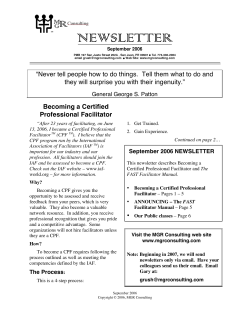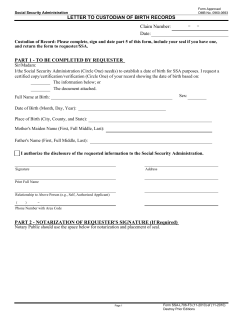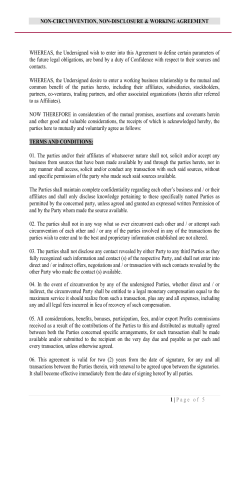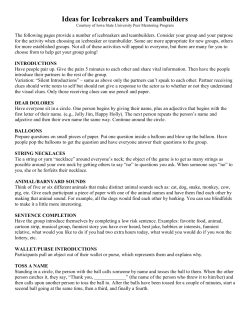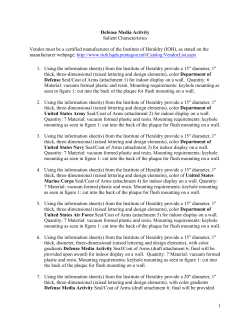
Uncommon Animals Classroom Activity
Uncommon Animals Classroom Activity The Classroom Activity introduces students to the context of a performance task, so they are not disadvantaged in demonstrating the skills the task intends to assess. Contextual elements include: an understanding of the setting or situation in which the task is placed, potentially unfamiliar concepts that are associated with the scenario; and key terms or vocabulary students will need to understand in order to meaningfully engage with and complete the performance task. The Classroom Activity is also intended to generate student interest in further exploration of the key idea(s). The Classroom Activity should be easy to implement with clear instructions. Please read through the entire Classroom Activity before beginning the activity with students to ensure any classroom preparation can be completed in advance. Throughout the activity, it is permissible to pause and ask students if they have any questions. Resources Needed: Chart paper, white board, or chalkboard Markers or chalk Some method of displaying ancillary materials1 Learning Goals: Students will understand the context of the key concepts related to the topics: o An animal may be considered uncommon because of where it is found or because of how it behaves. o Some people keep pets that are uncommon. Uncommon Animals Classroom Activity [Purpose: The facilitator’s goal is to help students understand what makes some animals uncommon. This task will also allow students to be active participants as they explore the concept of uncommon animals.] Facilitator says: “Today, we will get ready for the Uncommon Animals Performance Task. Let’s start by discussing what makes some animals uncommon. Some animals are uncommon because they are found in places where you wouldn’t normally expect to find them. Here is an example.” Note: The following section can be modified to accommodate various teacher-student interaction types such as a teacher-led discussion with the entire class, a teacher-student discussion for remote locations with a single student, or small groups. [Show Figure 1: The Seal. Note: For students who are visually impaired, read the description below the photo.] 1 Facilitators can decide whether they want to display ancillary materials using an overhead projector or computer/Smartboard, or whether they want to produce them as handouts for students. Facilitator says: “This picture is from a magazine article about a woman who lives by the shore in Washington. One day she found a seal in her backyard! It came on shore and rested in her backyard while it molted, that means it was losing one layer of fur and growing a new one. Turn to a partner and discuss what you think makes the seal uncommon.” [Give students two minutes to discuss with a partner. Observe students to ensure that students are on task.] [Choose a volunteer to share what makes this animal uncommon.] Possible student response (unscripted): The seal is uncommon because seals don’t normally go in people’s backyards. Facilitator says: “Turn to a partner and discuss what experience you have had or what you know about animals that behave in uncommon ways.” [Give students two minutes to discuss with a partner. Observe students to ensure that students are on task.] Facilitator says: “Let’s share what you discussed.” [Call on student volunteers to share.] Possible student responses (unscripted): Some animals behave in ways that are unusual. In some species, dads take care of the babies instead of the mom. Some animals become friends with animals that are not in their same species. For example, sometimes dogs and cats may become friends. Note: Add to the discussion any of the student responses in the list above that were not shared by students. Facilitator says: “Now, I want to see how well you can identify uncommon animals. For this activity, you are going to give a thumbs up if you think where the animal is found is uncommon. You will give a thumbs down if you think where the animal is found is common. I will call on someone to tell me why you chose either thumbs up or thumbs down.” Note: For students who are unable to physically provide a thumbs up or thumbs down, allow them to use their preferred response mode to participate in the activity. Facilitator says: “An elephant in the Arctic.” Student response: Thumbs up [Call on someone who has a thumbs up.] Note: If no students give a thumbs up, then provide them with guiding questions to lead them to the correct answer. For example, “When you have read about or seen an elephant, what was the area around the elephant like? Was it icy, grassy, or sandy? Polar bears live in the Arctic; have you ever known of or seen an elephant and a polar bear living in the same place?” Facilitator says: “Tell me why you think an elephant in the Arctic is uncommon.” Possible student response (unscripted): Elephants do not live in the Arctic. They usually live in places where it is warm. Facilitator says: “A camel in the hot desert.” Student response: Thumbs down [Call on someone who has a thumbs down.] Note: If no students give a thumbs down, then provide them with guiding questions to lead them to the correct answer. For example, “When you read about or have seen a camel, what was the area around the camel like? Was it icy, grassy, or sandy? A cactus lives in the desert because it has special arms that can store water for a long time, in case there is no rain.” Facilitator says: “Tell me why you think a camel in the desert is common.” Possible student response (unscripted): Camels live in places where it is hot and dry, like a desert. Facilitator says: “A kangaroo in South America.” Student response: Thumbs up [Call on someone who has a thumbs up.] Note: If no students give a thumbs up, then provide them with guiding questions to lead them to the correct answer. For example, “When you have read about or seen a kangaroo, what was the area around the kangaroo like? Was it flat empty land, full of trees, or sandy?” Facilitator says: “Tell me why you think a kangaroo in South America is uncommon.” Possible student response (unscripted): Kangaroos are only found in Australia. Facilitator says: “You did a great job identifying if where an animal is found might make it uncommon. I have another example of an animal that might be considered uncommon because of where it lives.” [Show Figure 2: The Hens. Note: For students who are visually impaired, read the description below the photo.] Facilitator says: “This picture is of a girl who wanted hens in her backyard. She lived in a city, so she had to ask her city council, the group that makes decisions for the city, to change a law to allow her to have the hens in her backyard. Take a few minutes and discuss with a partner what you think makes the hens uncommon.” [Give students two minutes to discuss with a partner. Observe students to ensure that students are on task.] [Choose a volunteer to share what makes these animals uncommon.] Possible student responses (unscripted): The hens are uncommon because hens usually live on farms and not in backyards. Facilitator says: “Like the girl who kept hens in her backyard, some people have pets that would not normally be thought of as a pet. Take a moment to discuss with a partner what you know about animals that people keep as pets. Focus on animals that would not normally be thought of as a pet.” [Give the students two minutes to discuss with a partner. Observe students to ensure that students are on task.] Facilitator says: “Raise your hand if you would like to share what you and your partner discussed.” Possible student responses (unscripted): Some people keep monkeys as pets. Some people have huge snakes as pets. Some people have rats as pets. Facilitator says: “From your discussions, you can tell that there are many different animals that are considered uncommon for different reasons.” Note: Make sure students arrive at the common understanding that: An animal may be considered uncommon because of where it is found or because of how it behaves. Some people keep pets that are uncommon. [Say and record the common understandings on the chart paper, a white board, or a chalkboard.] Facilitator says: “In your performance task, you will be learning more about animals and what makes them uncommon. The group work you did today should help prepare you for the research and writing you will be doing in the performance task.” Ancillary Material Figure 1 The Seal Picture Description: Figure 1 is a photograph of a seal. The seal has a round body that is small at the tail and head. It has two flippers at its sides half way down its body. Its body is covered with fur but the fur is molting off its body. The seal is lying on its side in a backyard near the shore. There is grass and mud underneath its body. The text says “Morna molts once a year. It is a natural part of being an elephant seal.” “The Seal in Our Backyard” by Andrea Lawson, from Highlights for Children magazine. Text copyright © 2012 by Highlights for Children. Reprinted by permission of Highlights for Children. Photograph copyright © 2012 by Highlights for Children. Reprinted by permission of Andrea Lawson. Ancillary Material Figure 2 The Hens Picture Description: Figure 2 titled, “The Hens”, is a photograph of a girl sitting with three hens in a backyard. Behind the girl is a hen house with a walkway for the hens to use to get into the house. The area where the girl is has a wire fence around it. On the other side of the wire fence there is a wooden fence. “Olivia’s Pet Project” by Katie MacNichol, from Highlights for Children magazine. Text copyright © 2012 by Highlights for Children. Reprinted by permission of Highlights for Children. Photograph copyright © 2012 by Highlights for Children. Reprinted by permission of Stacy Collins.
© Copyright 2026

